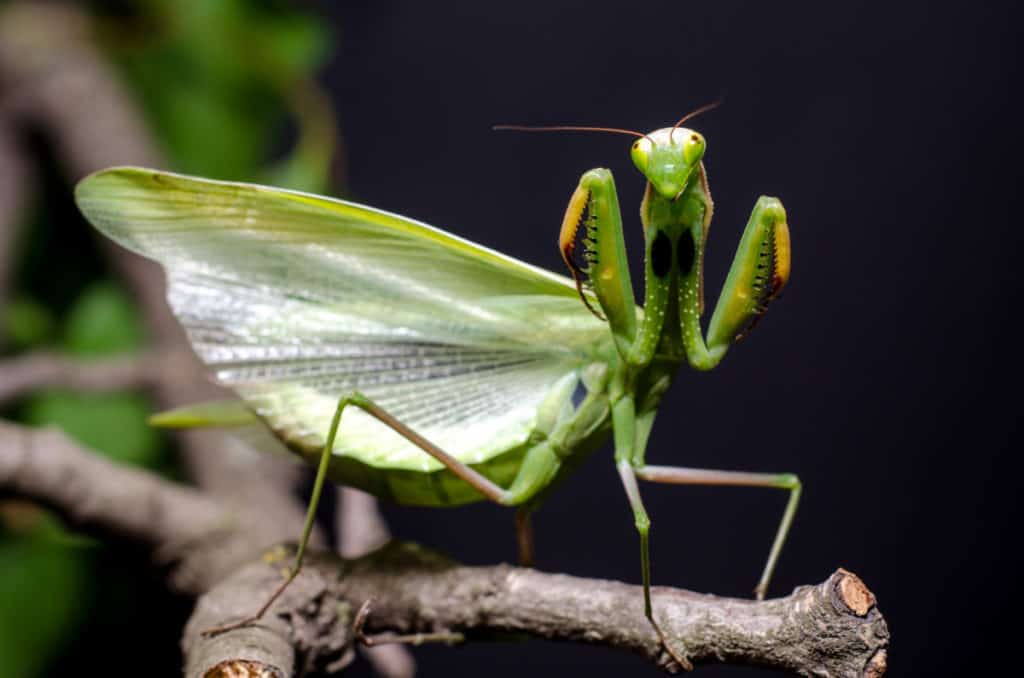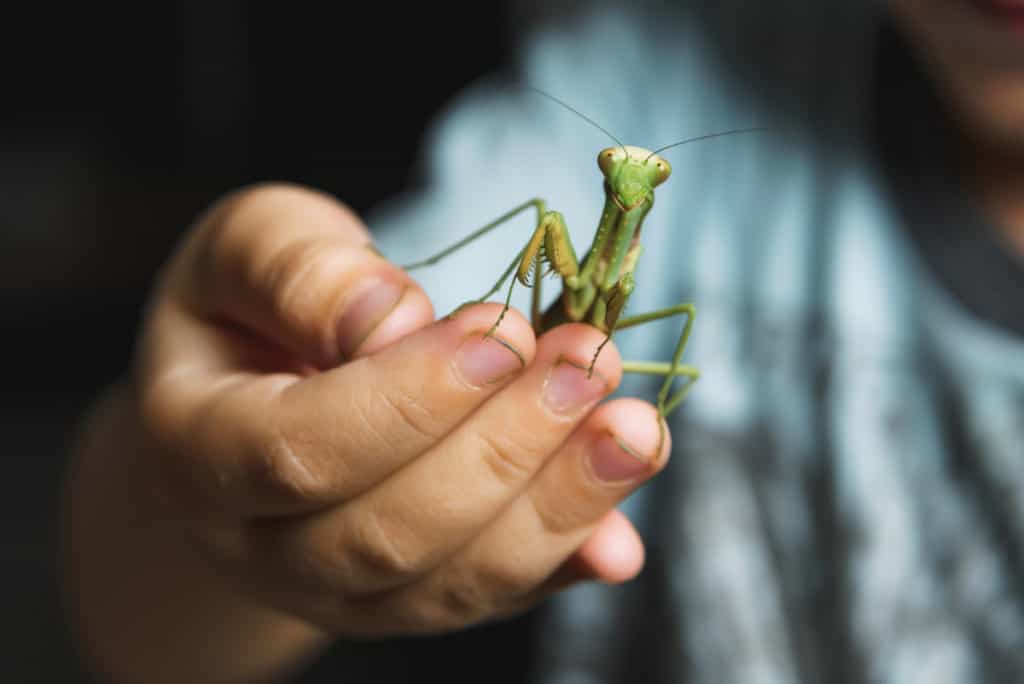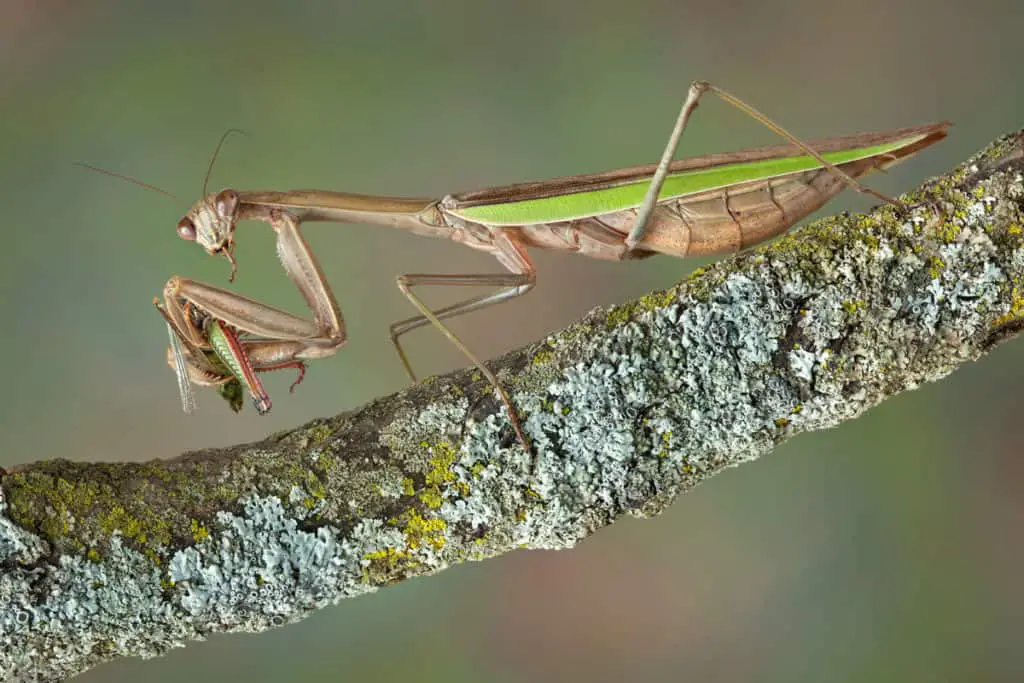Praying mantis can be a scary-looking insect with a fierce reputation for violently attacking its prey. We also often hear people say that praying mantis spit when they feel threatened.
But do praying mantis really spit? Contrary to popular belief praying mantis don’t spit. This myth is perpetuated because walking insects like the two-striped walking stick insect squirt a potent smelling defensive spray to deter predators. Praying mantis, despite looking like a walking stick don’t have venom or spitting glands.
If you really want to know more about stick insects maybe check out this article we have written, Praying Mantis Vs Stick Bug. Are They The Same Thing?
To understand why a praying mantis does not spit, it is important to know what its defense mechanism is.
Read on to find out more about the praying mantis.
How Do Praying Mantis Defend Themselves?
The praying mantis defends itself by announcing its presence and not by spitting. The smart insect stands tall on its back legs and raises its front legs which are larger in size compared to the other legs. It then opens its wings to give the appearance of girth and proceeds to kick out its front legs to fight off the predator. It uses the same front legs to capture prey which makes them very strong appendages.

This dance is typically harmless to human beings. But when at close quarters the mantis may take a nip at your finger when they mistake it for food.
Another reason why it is believed that praying mantis spit is because when under threat they make a hissing sound similar to the typical spitting sound.
You might be thinking, What about their bites? They can tear the heads off their prey. Can they also bite people? The good news is that there is no need to be threatened by these insects, they don’t pose a threat to humans.
For more about the praying mantis bite, check out this article we have written, Do Praying Mantis Bite?
Praying mantis can make excellent pets because they do not sting and are not vectors of any diseases. A praying mantis in captivity can live for a year to 14 months and they are easy to care for.
Can You Safely Hold A Praying Mantis?
Praying mantis can be handled safely and interestingly they do not seem to be averse to being held. In fact, when you place a mantis on your hand they begin to walk up your arm proving they are comfortable with human presence.

Before handling any praying mantis check them to ensure they haven’t just molted or are about to molt. If the mantis is about to molt, they lose their appetite and they are almost completely inactive. Strictly do not feed them or try to handle them.
On the other hand, a freshly molted praying mantis has a paler color and its exoskeleton is still see-through. Give them some time for the exoskeleton to harden and they will then be ready to feed. Look out for the shed exoskeleton nearby. 24 hours to a few days is sufficient depending on the growth stage of the mantis to allow them to become comfortable with being handled again.
The nymphs are particularly fast and can quickly climb walls to explore the terrain while the females are more guarded and temperamental. The bigger females are known to grab you with their tibial spines and bite you when you rush your hand towards them to cup them.
The spines can pierce your skin painfully. If this happens do not try and flick the mantis which in all likelihood has a tight grip on your skin. Instead, use a pair of small tongs or a pen to pry their grip open.
Handle the praying mantis over a flat surface or the floor and be very careful. They like to fly or jump and they may be injured due to a fall from a high surface as they try to get away. The heavier-bodied, fully grown females are quite skittish and a fall can hurt them.
Adult males love to fly around and they can cover quite a distance. So, if you are handling a male, ensure that the windows are closed or you will lose him.
For more on how praying mantis fly, check out this article we have written, Do Praying Mantises Have Wings And Can They Fly?
What Do You Need To Keep A Pet Praying Mantis?
So, to successfully keep a praying mantis as a pet you will need
- A perch inside a cage
- Heater
- Houseplant spray
- A reliable food supply
Some of the requirements may sound odd so here is a breakdown of what each does.
The Perch And The Cage
The praying mantis is not comfortable on the floor. They are natural climbers happy to exist on the higher perches of their habitat. The perch offers them a safe hunting and molting place away from the ground. Also, they instinctively stay off the ground to avoid predators. This perch should be placed strategically allowing the mantis to be able to access it off the ground and if it falls off, not to harm itself.
The cage is useful in confining them so that they are not flying all over the place. Some people keep their praying mantis in a small aquarium that is made from plastic or glass. But any clear glass or plastic container can be used as a cage. The cage should allow air in to ensure that the mantis is breathing properly. Unfortunately, moist and stagnant air can kill your mantis
Also, make sure that the cage’s dimensions are twice as tall as the length of your pet praying mantis. Here is why: when the praying mantis is molting, it anchors its back feet on the top of the cage. It then proceeds to tear the skin on its back and slowly slides out of this old skin. So, if the cage is not twice the length of the mantis, the molting process is curtailed and that hampers development and can cause death.
Also, remember that the praying mantis stands onto its feet when hunting and it requires enough space to do that.
Heater
The praying mantis favors a warm climate which must be mimicked in captivity as well. In the warm months of summer, you do not need a heater because the ambient temperature is conducive for the mantis. But in winter, consider buying a low-powered heat pad to keep your pet warm.
House Plant Spray
These insects drink droplets of water from plant surfaces to keep hydrated. A houseplant spray gun allows you to introduce just enough water inside the cage to form the size of droplets the mantis will drink from. Lightly spray the cage a couple of times weekly to keep the supply.
And when the mantis is molting you need to give it more water because they need more humidity at this time. Plus, they rarely eat during molting so they need hydration to keep them going.
Reliable Food Supply
Your pet mantis needs live food to survive. So, introduce live insects into the cage and not dead ones. You can buy insects in tubs and also, you need to feel comfortable with the mantis’s feeding habits. Feed your pet just as much as it needs and if the food is not eaten within an hour, consider removing it so that you do not stress your praying mantis.

You will know that your mantis is about to molt because it will fast from food. It is essential not to introduce any food into the cage and remove any uneaten food. Leaving food in the cage while the mantis is molting will interfere with the freshly molted mantis which is still very delicate.
The digestive system of the praying mantis is located in the abdomen. The average mantis can eat up to 16 crickets in one day. Their food is mostly digested leaving them with very little waste. Their strong digestive enzymes secreted by the gastric ceca glands are capable of digesting large prey.
The Wrap Up
A praying mantis is generally a friendly pet that poses no danger to human beings. They can be bought from a store or caught in the wild. When in contact with the praying mantis, you have no fear that the insect will spit on you.
But as mentioned before grown females can be cantankerous so you have to be more careful when handling them.
If you are interested we have a bunch of articles about other bugs and if they are harmful or dangerous. Check out the links below for more access to these articles:
Do Ladybugs Bite? They’re So Cute, Surely Not!
Sources
https://thecheekymantis.co.uk/handling-your-mantis
https://www.pbspettravel.co.uk/blog/keeping-praying-mantis-as-pets-the-beginners-guide/
